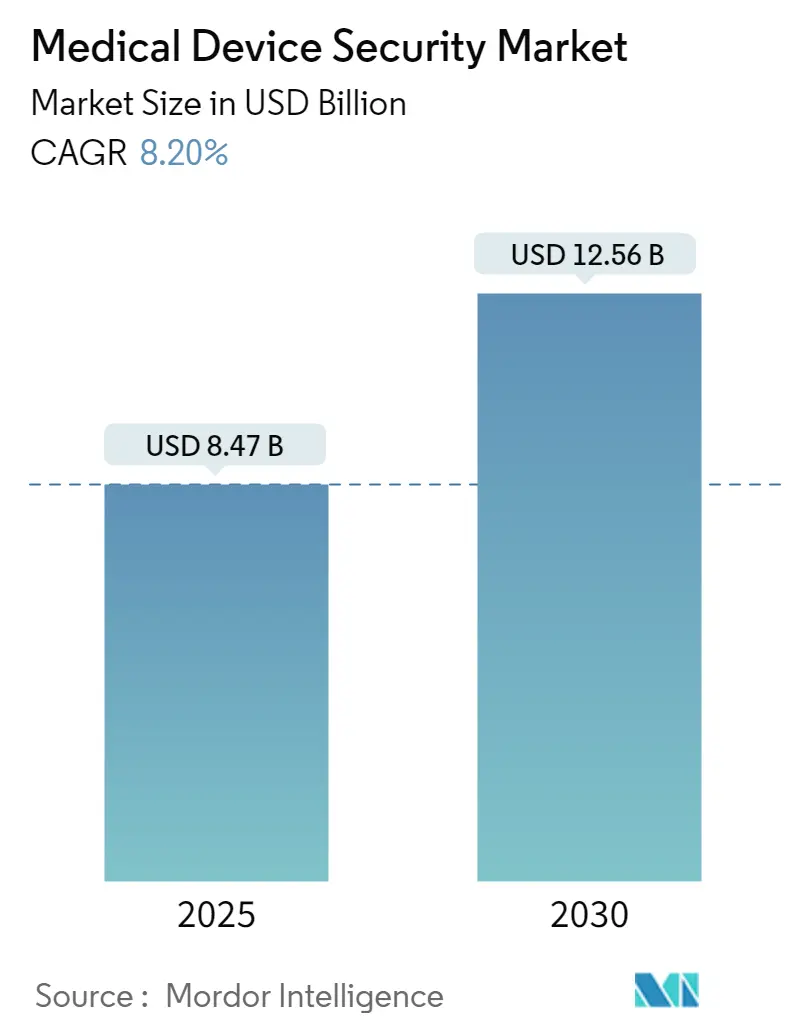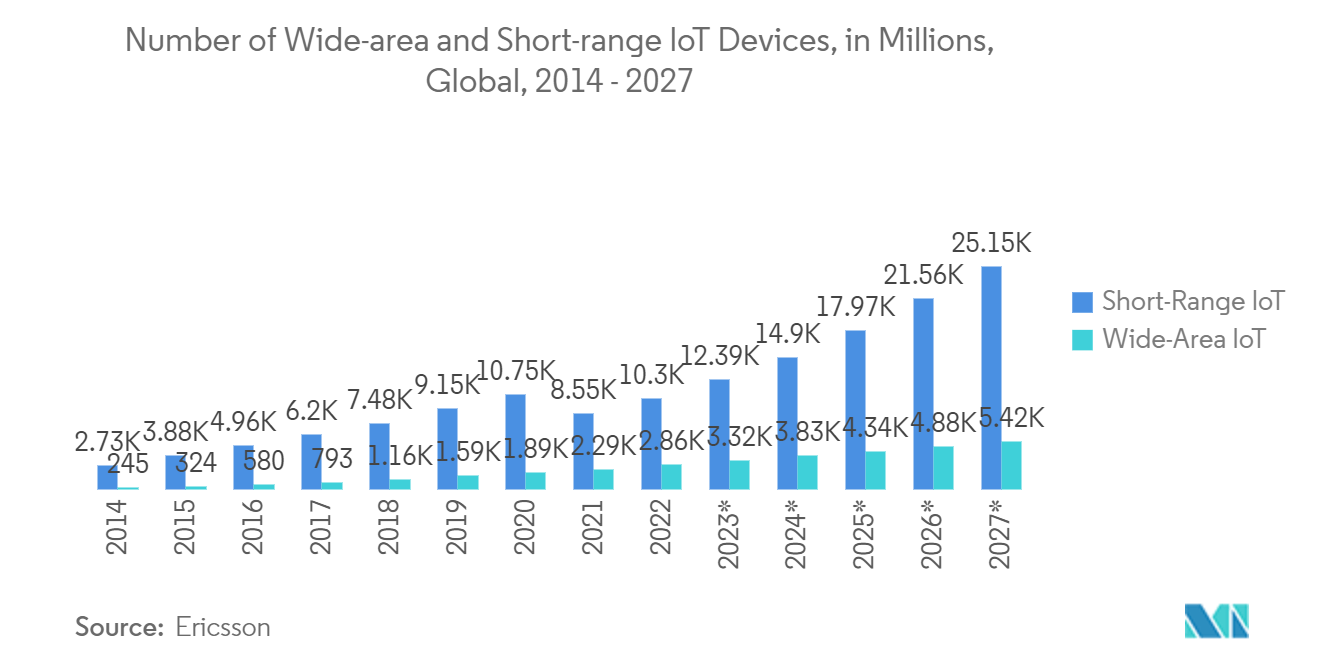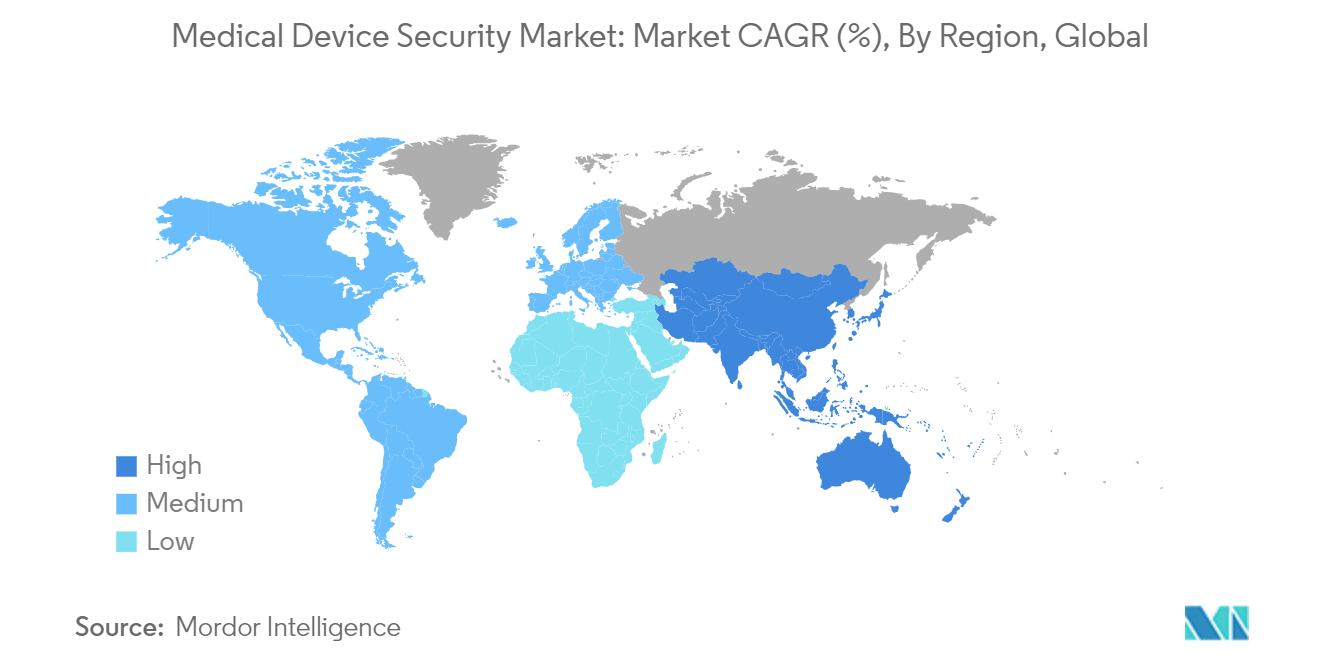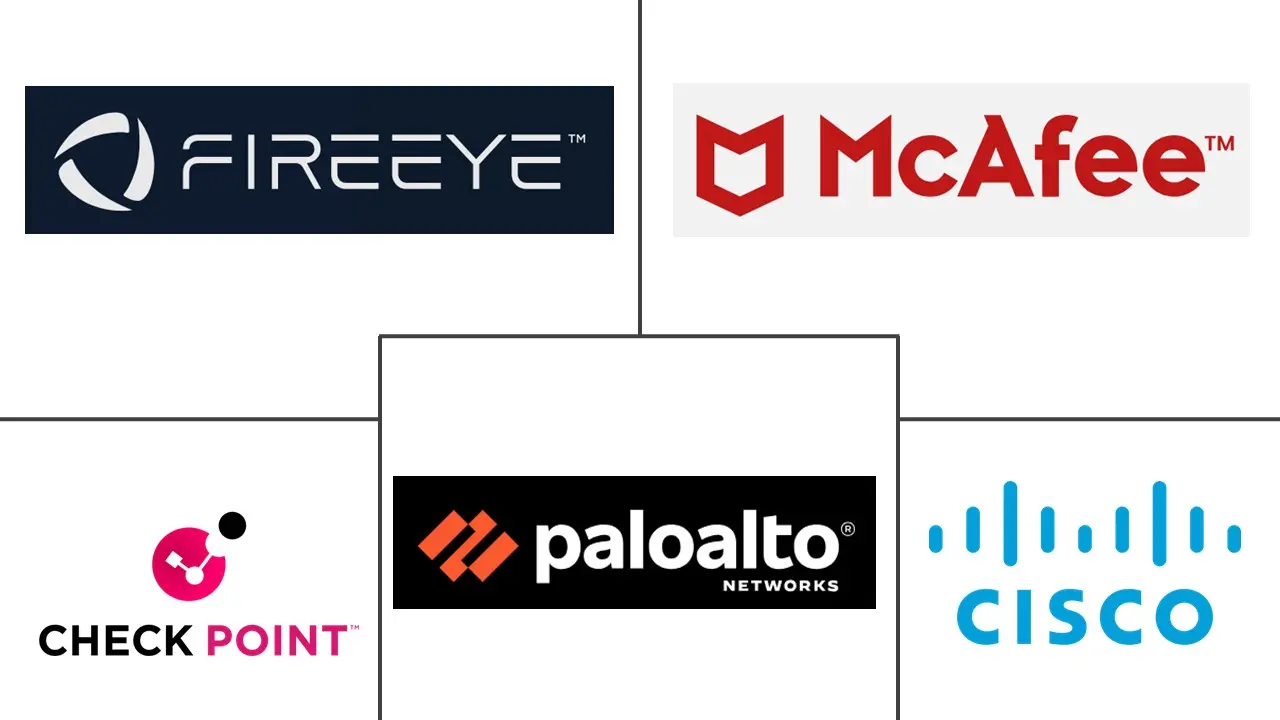Medical Device Security Market Size and Share

Medical Device Security Market Analysis by Mordor Intelligence
The Medical Device Security Market size is estimated at USD 8.47 billion in 2025, and is expected to reach USD 12.56 billion by 2030, at a CAGR of 8.2% during the forecast period (2025-2030).
The healthcare industry has been witnessing a significant transformation throughout the past few years, aided by the transformative nature of IoT technologies and advancements in computing power, wireless technologies, and data analytics techniques, such as Big Data. Big Data is currently being deployed in medical facilities and the medical research sector to analyze complex heterogeneous medical data that involves proteomics, genomics, and pharmacogenomics worldwide.
- There is a rise in the number of connected medical devices and advancements in software that may capture and transmit medical data and data analytics services that help medical practitioners drive insights into and promote the delivery of predictive, preventive, personalized, and participatory medicines. The need to secure connected medical devices is rising owing to the increasing number of data breach incidents in the healthcare sector.
- The growing number of connected devices used by employees in the healthcare sector leads to more information sharing. It also places the endpoint at higher risk than ever.
- The healthcare industry is experiencing a transformation in cyber security strategy from a compliance and Health Insurance Portability and Accountability Act (HIPAA)-focused approach to a more comprehensive and security-centric approach. The governments are expected to impose stricter regulations about the safety and security of IoMT devices. Healthcare providers need to step up the game on cyber resilience.
- Cybercriminals seeking to exploit medical device and system vulnerabilities increasingly target the healthcare sector. High-profile incidents, such as ransomware attacks on hospitals, highlight the urgent need for robust cybersecurity measures. Healthcare organizations may prioritize allocating limited budgets to address immediate security threats.
- Lack of awareness about medical surveillance equipment and scarcity of monetary funds for healthcare security in underdeveloped countries are expected to hamper the growth of the medical device security market.
- Healthcare delivery organizations quickly scaled the implementations of technologies designed to support the response to COVID-19, including telehealth platforms, new fleets of medical devices, and other patient support technologies. This included temporary care sites, labs, troves of connected devices, and telehealth platforms desperately needed to support patient care.
Global Medical Device Security Market Trends and Insights
Increasing Demand for Connected Medical Devices is Expected to Drive the Market Growth
- The healthcare sector has adopted new technologies, such as smart wearables and remote monitoring equipment embedded with IoT-enabled technologies, to offer life-critical services and treatments. Healthcare services are moving online to capture patient data for better health services. These wearable medical devices are gaining immense popularity due to improved technologies and their compatibility with regularly used instruments, such as smartphones. Health awareness promotes the growth and use of these smart wearables to monitor health and fitness conditions.
- As cyberattack cases continue to rise, the security of connected medical devices is becoming challenging. With more medical devices integrated into clinical networks, real-time connected medical device utilization data adds greater accuracy to emergency preparedness and capital planning initiatives across hospitals and health systems.
- In August 2023, Medcrypt Inc., the proactive cybersecurity solution provider for medical device manufacturers (MDMs), partnered with Netrise, the company offering granular visibility into the world's XIoT security problem to solve critical cybersecurity challenges in the healthcare industry. This collaboration would offer the MDMs a Software Bill of Materials (SBOM) lifecycle management solution that would enable device manufacturers to proactively identify and address the potential security risks and ensure the safety and integrity of their medical devices.
- The increasing proliferation of connected Internet of Things (IoT) devices in the healthcare sector drives the growth of the medical device security market. According to Ericsson, in 2022, the number of short-range Internet of Things (IoT) devices reached 10.3 billion globally. That number is expected to increase to 25 billion by 2027. The wide-area IoT devices would be about 2.9 billion in 2021 and are forecasted to reach 5.4 billion by 2027.

North America is Expected to Hold Significant Market Share
- Healthcare is one of North America's most regulated industries due to privacy and security concerns associated with digital patient records. Regulations, such as the Health Insurance Portability and Accountability Act (HIPAA) and the Health Information Technology for Economic and Clinical Health (HITECH) Act, ensure a steady growth in the penetration rates of cyber security solutions in the country's healthcare sector.
- The United States and Canada have developed economies that enable them to invest heavily in R&D. Rising digitization throughout the industrial emphasis areas, steady technological advancements, and rising penetration of smart connected devices have all contributed to the growth of the North American IoT device market. The increased usage of connected devices and associated network infrastructure, as well as the increased collaboration of network, hardware, and software providers, are the primary drivers that assist in expanding the IoT market in North America.
- The proliferation of IoT medical devices demands threat-prevention methods. In June 2023, the US-based medical device cybersecurity organization MedCrypt partnered with Stratigos Security to provide security assessments and penetration testing, offering a suite of third-party assessment and advisory services.
- In November 2023, NYU Langone Health partnered with Philips to adopt new health technology solutions in patient safety, quality, and outcomes. The new collaboration to unlock patient data for precision diagnosis and treatment includes digital pathology, clinical informatics, and innovative AI-enabled diagnostics with enterprise monitoring as a service model.

Competitive Landscape
The medical device security market is highly fragmented, with the presence of major players like Check Point Software Technologies, Cisco Systems Inc., FireEye Inc., McAfee LLC, and Palo Alto Networks Inc. Players in the market are adopting strategies such as partnerships and acquisitions to enhance their product offerings and gain sustainable competitive advantage.
- December 2023 - Cisco, one of the enterprise networking and security leaders, unveiled the Cisco AI Assistant for Security. This marks a major step in making artificial intelligence (AI) pervasive in the Security Cloud, Cisco's unified, AI-driven, cross-domain security platform. The AI Assistant would help customers make informed decisions, augment their tool capabilities, and automate complex tasks.
- July 2023 - Cynerio and Check Point Software Technologies announced a partnership to offer healthcare organizations comprehensive security for their medical IoT devices. Cynerio's 360 platforms would offer functionality critical to securing healthcare IoT devices, including device discovery, patch guidance, micro-segmentation, and attack detection.
Medical Device Security Industry Leaders
-
Check Point Software Technologies
-
Cisco Systems Inc.
-
FireEye Inc.
-
McAfee LLC
-
Palo Alto Networks Inc.
- *Disclaimer: Major Players sorted in no particular order

Recent Industry Developments
- November 2023: Ostium Group, one of the global leaders of medical device startups dedicated to revolutionizing orthopedic surgical instrumentation, announced its strategic partnership with Eastman, a global specialty materials company. The collaboration focuses on incorporating Eastman's sustainable packaging solution, Eastar 6763 Renew copolyester, into Ostium Group's innovative CILLAR Acetabular and Femoral kits for total hip replacements.
- November 202: Cybeats Technologies Corp. announced a partnership with the Health Information Sharing and Analysis Center, which focused on enhancing cyber and physical security in the healthcare industry. Cybeats and Health-ISAC would go to market with a joint Software Bill of Materials management solution targeting Medical Device Manufacturers (MDMs) and Healthcare Delivery Organizations (HDOs).
Global Medical Device Security Market Report Scope
Medical devices that are vulnerable to security threats are protected using industry-standard guidelines. Medical device manufacturers mitigate the device security risks using software solutions and services and encrypt data for secure data transfer and evading data loss. A mix of bottom-up and top-down approaches has been taken to arrive at the market estimates for this market study on the medical devices security market.
The medical device security market is segmented by solutions (data loss prevention solutions, antivirus/antimalware solutions, encryption solutions, network and endpoint security, identity and access management solutions, intrusion detection systems/intrusion prevention systems, risk and compliance management, and other solutions), device type (hospital medical devices, internally embedded medical devices, and wearable and external medical devices), and geography (North America, Europe, Asia-Pacific, Latin America, and Middle East & Africa). The report offers the market size in value terms in USD for all the abovementioned segments.
| Data Loss Prevention Solutions |
| Antivirus/Antimalware Solutions |
| Encryption Solutions |
| Network and Endpoint Security |
| Identity and Access Management Solutions |
| Intrusion Detection Systems/Intrusion Prevention Systems |
| Risk and Compliance Management |
| Other Solutions |
| Hospital Medical Devices |
| Internally Embedded Medical Devices |
| Wearable and External Medical Devices |
| North America |
| Europe |
| Asia-Pacific |
| Latin America |
| Middle East & Africa |
| Solution | Data Loss Prevention Solutions |
| Antivirus/Antimalware Solutions | |
| Encryption Solutions | |
| Network and Endpoint Security | |
| Identity and Access Management Solutions | |
| Intrusion Detection Systems/Intrusion Prevention Systems | |
| Risk and Compliance Management | |
| Other Solutions | |
| Device Type | Hospital Medical Devices |
| Internally Embedded Medical Devices | |
| Wearable and External Medical Devices | |
| Geography | North America |
| Europe | |
| Asia-Pacific | |
| Latin America | |
| Middle East & Africa |
Key Questions Answered in the Report
How big is the Medical Device Security Market?
The Medical Device Security Market size is expected to reach USD 8.47 billion in 2025 and grow at a CAGR of 8.20% to reach USD 12.56 billion by 2030.
What is the current Medical Device Security Market size?
In 2025, the Medical Device Security Market size is expected to reach USD 8.47 billion.
Who are the key players in Medical Device Security Market?
Check Point Software Technologies, Cisco Systems Inc., FireEye Inc., McAfee LLC and Palo Alto Networks Inc. are the major companies operating in the Medical Device Security Market.
Which is the fastest growing region in Medical Device Security Market?
Asia Pacific is estimated to grow at the highest CAGR over the forecast period (2025-2030).
Which region has the biggest share in Medical Device Security Market?
In 2025, the North America accounts for the largest market share in Medical Device Security Market.
What years does this Medical Device Security Market cover, and what was the market size in 2024?
In 2024, the Medical Device Security Market size was estimated at USD 7.78 billion. The report covers the Medical Device Security Market historical market size for years: 2019, 2020, 2021, 2022, 2023 and 2024. The report also forecasts the Medical Device Security Market size for years: 2025, 2026, 2027, 2028, 2029 and 2030.
Page last updated on:
Medical Device Security Market Report
Statistics for the 2025 Medical Device Security market share, size and revenue growth rate, created by Mordor Intelligence™ Industry Reports. Medical Device Security analysis includes a market forecast outlook for 2025 to 2030 and historical overview. Get a sample of this industry analysis as a free report PDF download.



